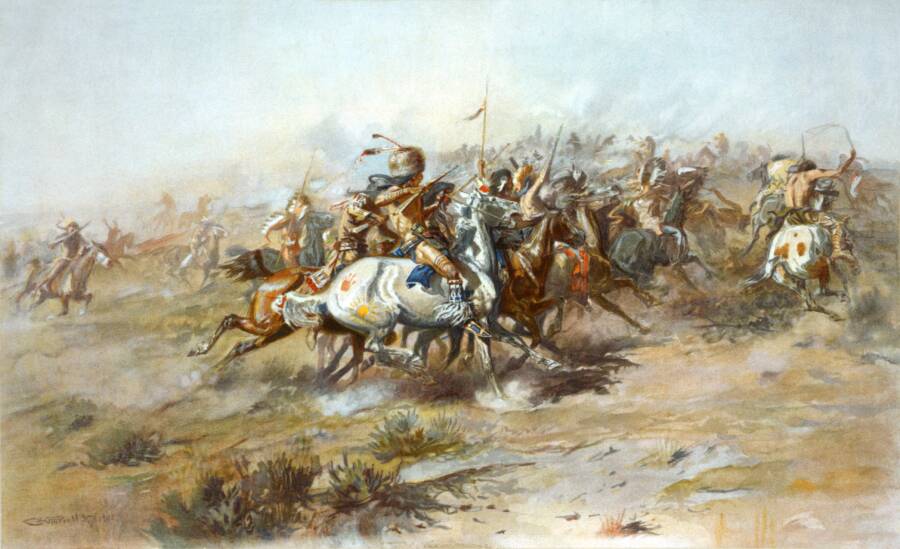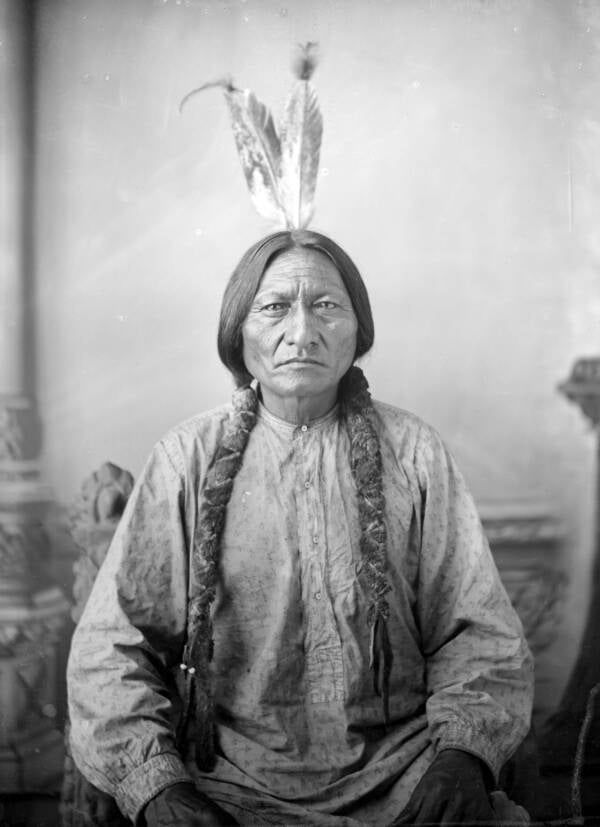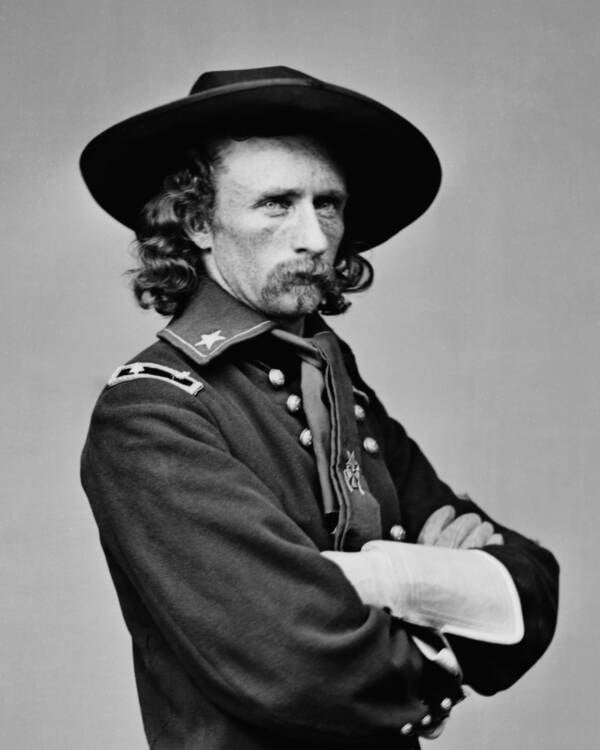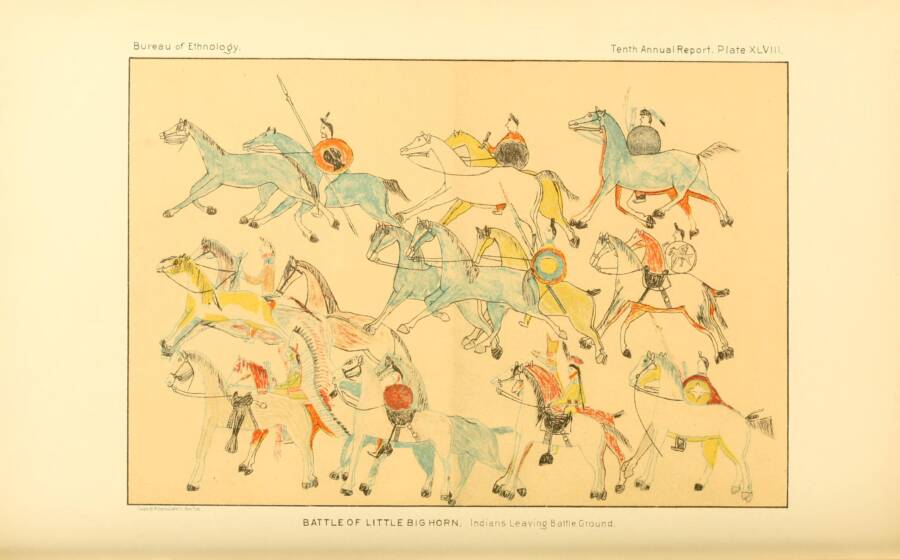On June 25, 1876, Lieutenant Colonel George A. Custer led 210 men into an attack against 3,000 Sioux and Cheyenne warriors — and the Native Americans killed every last one of them.

Charles Marion Russell/Library of CongressA 1903 lithograph depicting the Battle of Little Bighorn, the setting for Custer’s Last Stand.
George Armstrong Custer lives on in American memory largely for one reason: his death. For generations, the account of Custer’s Last Stand has been legendary.
As the story goes, Custer heroically fought against a massive Native American assault at the Battle of Little Bighorn in Montana Territory on June 25, 1876, staving them off until he and his army were overcome and slaughtered.
But that story gets a lot wrong. So how did the Battle of Little Bighorn actually play out? And how did the legend of Custer’s Last Stand grow in the American mythos?
Setting The Stage For Custer’s Last Stand
Initially, George A. Custer didn’t appear cut out for a prominent position in the U.S. Army: He graduated last in his class at West Point in 1861. However, he was immediately commissioned as a second lieutenant for the Union Army in the Civil War.
After the war, Custer found himself on the frontier fighting a new enemy: Native Americans.
In 1874, Custer led an expedition into the Black Hills, a sacred hunting ground for the Lakota Sioux. His orders were to establish a fort to protect the growing settler population and to search for gold.
Custer and his men did indeed find gold, sparking a gold rush in the area. This ultimately laid the conditions for the Battle of Little Bighorn two years later.
Despite the Treaty of Fort Laramie signed a decade earlier, prospectors flooded the Black Hills region. And instead of trying to enforce the treaty and expel the miners, the administration of Ulysses S. Grant issued an ultimatum to the Sioux and other tribes: move back to reservations, or the Army would use deadly force.

D. F. Barry/Library of CongressSitting Bull, an important leader for the Lakota. Bismarck. 1883.
In spite of this ultimatum, several Lakota Sioux bands gathered with their Cheyenne allies near the eventual battlefield at Little Bighorn to perform a traditional sun dance ceremony.
During the ceremony, Lakota leader Sitting Bull predicted a great victory for the combined Native force, according to Encyclopedia Britannica. The chief envisioned “soldiers falling into his camp like grasshoppers from the sky.”
Around the same time, Custer and his 7th Cavalry were ordered to trap the Native Americans and await backup forces to break up their camp and ultimately drive them into reservations. However, when Custer’s scouts reported that the Lakota-Cheyenne force had detected his presence on June 25th, Custer decided to attack on his own.
The stage was set for the Battle of Little Bighorn.
Last Stand Or ‘Tactical Disintegration’?
We will likely never know for certain what Custer or his adversaries did at the Battle of Little Bighorn, but historian Thomas Powers painted an engaging picture from the Sioux and Cheyenne perspective in Smithsonian magazine.
Lakota warrior Crazy Horse led the initial assault on Custer’s position. Upon seeing the Lakota and Cheyenne’s sheer numbers — as many as 3,000 warriors — Custer “suspected he was in a bad scrape,” Lakota chief Gall later recalled. “From that time on Custer acted on the defensive.”

Mathew Brady/Library of CongressGeorge Armstrong Custer during the Civil War. 1865.
As Custer’s troops wearily attempted to reach higher ground, the Native forces kept pursuing them. In skirmish after skirmish, the warriors pushed Custer’s troops higher and higher, and more and more U.S. troops fell.
At one point, Crazy Horse’s men even forced Custer’s horses to stampede, panicking Custer’s forces even further.
In the end, Custer was simply too outnumbered. As his men reached the eponymous Custer Hill, only a few troops remained. “We circled all ’round them,” Cheyenne chief Two Moons later said, “swirling like water ’round a stone.”
While the idea of the “Last Stand” has achieved mythical status, contemporaneous accounts shot down that conclusion.
It was “a rout, a panic, until the last man was killed,” Captain Frederick Benteen, who led 125 men in an effort to surround the Native American forces while Custer and his army attacked, testified later. “You can take a handful of corn and scatter it over the floor, and make just such lines, there were none.”
“The evidence suggests ‘tactical disintegration,’ which is a nicer way of saying that they got really scared and started to run,” concluded historian Tim Lehman for How Stuff Works.

Red Horse/Smithsonian InstitutionA page from Miniconjou Sioux warrior Red Horse’s ledger description of the Battle of Little Bighorn. 1881.
So why did Custer fail so drastically?
Historians haven’t come to a true consensus on the answer to that question, but their explanations generally boil down to Custer ignoring his Crow scouts and underestimating his opponents’ numbers. His decision to split up his troops, compounded by poor communication, likely exacerbated that mistake — and led to his legendary death.
How The Bloody Battle Turned Into The Myth Of ‘Custer’s Last Stand’
News of Custer’s Last Stand reached New York City by July 4th. The New York Herald broke the story. In its view, Custer’s men “died as grandly as Homer’s demigods… Success was beyond their grasp so they died — to a man.”
Its report had just one major problem: In a rush to get a scoop and outdo its rivals with purple prose, it fabricated many details about the Battle of Little Bighorn.
Resultantly, the “Last Stand” myth propagated through at least three separate avenues.
First, Custer’s widow, Libbie, wrote books and articles praising her husband’s valor. Her campaigning made it “a very touchy matter for any military writer or officer to criticize Custer” at the time, wrote historian Gene Smith for American Heritage.
In the 1880s, meanwhile, Buffalo Bill’s Wild West Show and other imitators such as Pawnee Bill reenacted the Last Stand to widespread popular acclaim. Sitting Bull himself even participated in some of the reenactments.
And on the 20-year anniversary of the battle, beer company Anheuser-Busch published lithographs emphasizing Custer’s heroism against a Native American onslaught.
The “Last Stand” mythos played into the broader image that “Americans more broadly were defending themselves from these ‘aggressive hordes’ of Indians who represented this savagery that was well beyond the pale of civilization,” said Lehman.

Siegel, Cooper & Co./Library of CongressA reenactment of Custer’s Last Stand in Pawnee Bill’s Wild West Show in 1905.
As for the participants in the battle itself, Major Marcus Reno — who led an additional force of 140 men against the Cheyenne and Lakota Sioux warriors at the same time as Custer and suffered heavy casualties himself — called for a commission of inquiry to defend against accusations of cowardice in failing to come to Custer’s aid. The commission largely cleared his name.
However, the commission was not as generous with Benteen, who received censure for not expeditiously marching to the battlefield — despite likely saving Reno’s contingent.
Crazy Horse and Sitting Bull led the Native resistance to Anglo encroachment for a few more months, but the backlash created by Custer’s Last Stand only led to hardened resolve from the U.S. Army.
Congress passed a “sell or starve” ultimatum, and one by one, the indigenous tribes involved in the Battle of Little Bighorn capitulated. They would sell their lands in the Black Hills and move to reservations.
Although they had won the battle, they would go on to lose the war.
After reading the true story of Custer’s Last Stand, learn more about the life of Sitting Bull, who played a part in the lead-up to the battle. Then, go back in time to read about Red Cloud, who fought against the U.S. Army during the 1860s.





